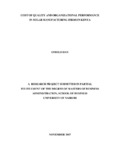| dc.description.abstract | Cost of quality, following previous research reports have been identified to have significant influence on the nature and possible level of final product or service quality that would satisfy the need of the customer with resultant organizational performance leverage. Cost of quality systems implementation by organizations is no doubt a consumer of resources, hence the need for its recognition, identification, measurement and evaluation. Saijala, Basak and Viswanadhan (2015) in their study on Hidden Cost of Quality: measurement and analysis, held that Cost of quality are those expenses incurred by an organization in an attempt to achieving and maintaining good quality alongside managing poor quality throughout its line of operations with the aim to attaining highest level of customer satisfaction. The Kenya Sugar Directorate (2009) held that locally produced sugar manufacturers has remained less-competitive with the cost of production at about $ 600 per ton and therefore higher than anywhere else in the COMESA region. This is significant and would impact the performance of the organizations, which was the attraction to the researcher, who aimed at finding out possible contribution and relationship between cost of quality and organizational performance, through its influence on the cost of production. The study employed descriptive cross-sectional survey as the desired research design, alongside quantitative statistical analysis tools. The research findings indicated strong correlation coefficients which measured the quality of prediction for the dependent variable, organizational performance, by the COQ categories as held in table 25 with R = 0.994 for prevention cost expenditure(PCE) which shows a strong level of prediction for the dependent variable, organizational performance. The R2 being the coefficient of determination for PCE at R2 = 0.970 translates to 97% strength of prediction with the other 3% not explained. R value for appraisal cost expenditure (ACE) at R = 0.949, equally shows a strong level of prediction of the dependent variable. The R2 which is the coefficient of determination for ACE, R2 = 0.752 indicate 75.2% strength with the other 24.8% is not explained. R value for external failure cost expenditure (EFCE) at R = 0.983, which also shows a strong level of prediction. The R2 which is the coefficient of determination for EFCE, R2 = 0.916 indicating 91.6% with the other 8.4% is not explained. These levels of prediction strengths lead to a conclusion that COQ categories activities would attract significant expenditure levels by the sugar manufacturers so as to have strong influence the overall organization performance, hence the proof for the relationship between cost of quality and organizational performance in the sugar manufacturing firms in Kenya. | en_US |



